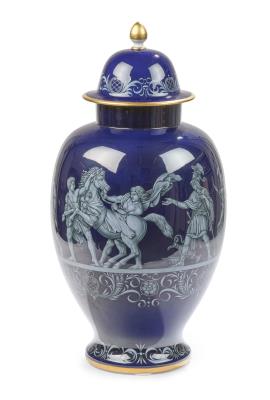A Large Lidded Vase with Limoges Paintwork and Classical Frieze, Meissen, Second Half of the 20th Century
A Large Lidded Vase with Limoges Paintwork and Classical Frieze, Meissen, Second Half of the 20th Century
porcelain with cobalt blue ground and fine, pastose on-glaze painting, covered bulbous vase with all-round pictorial frieze, height 65.5 cm, underglaze blue crossed swords mark, (GO)
In the mid-19th century, in response to the renewed interest of historicism in past style periods such as the Renaissance, new decorations and vessel forms were also developed at the Meissen Manufactory. These porcelains with Limoges painting refer to the city of Limoges in France, which was known for its richly decorated enamelware since the Middle Ages. In the 16th century in particular, a centre developed here for paintings "en grisaille", i.e. finely painted figures in shades of white or grey against a dark background with mostly classical pictorial themes.
This French Renaissance decoration, known for its perfect execution and richness of detail, was taken up by Ernst August Leuteritz, who is considered the most productive designer of the Meissen Porcelain Manufactory of the 19th century. From 1849, he was head of the design department in Meissen and primarily designed porcelain in the style of Classicism, Neo-Gothic and Neo-Renaissance.
He developed and established Limoges painting as a new, "modern" enrichment of the repertoire of the Meissen Manufactory, which was significantly influenced by Baroque and Rococo. These porcelains are characterised by clear neo-classical vessel forms and finely executed grisaille painting on a cobalt blue ground with ancient scenes.
The all-round frieze appears to depict a scene from the life of Alexander the Great and the taming of his horse Bucephalus.
Expert: M.A. Georg Ottomeyer
 M.A. Georg Ottomeyer
M.A. Georg Ottomeyer
+43-1-515 60-538
georg.ottomeyer@dorotheum.at
25.04.2024 - 13:00
- Odhadní cena:
-
EUR 50.000,- do EUR 70.000,-
Sledovat položku Sledování ukončit
A Large Lidded Vase with Limoges Paintwork and Classical Frieze, Meissen, Second Half of the 20th Century
porcelain with cobalt blue ground and fine, pastose on-glaze painting, covered bulbous vase with all-round pictorial frieze, height 65.5 cm, underglaze blue crossed swords mark, (GO)
In the mid-19th century, in response to the renewed interest of historicism in past style periods such as the Renaissance, new decorations and vessel forms were also developed at the Meissen Manufactory. These porcelains with Limoges painting refer to the city of Limoges in France, which was known for its richly decorated enamelware since the Middle Ages. In the 16th century in particular, a centre developed here for paintings "en grisaille", i.e. finely painted figures in shades of white or grey against a dark background with mostly classical pictorial themes.
This French Renaissance decoration, known for its perfect execution and richness of detail, was taken up by Ernst August Leuteritz, who is considered the most productive designer of the Meissen Porcelain Manufactory of the 19th century. From 1849, he was head of the design department in Meissen and primarily designed porcelain in the style of Classicism, Neo-Gothic and Neo-Renaissance.
He developed and established Limoges painting as a new, "modern" enrichment of the repertoire of the Meissen Manufactory, which was significantly influenced by Baroque and Rococo. These porcelains are characterised by clear neo-classical vessel forms and finely executed grisaille painting on a cobalt blue ground with ancient scenes.
The all-round frieze appears to depict a scene from the life of Alexander the Great and the taming of his horse Bucephalus.
Expert: M.A. Georg Ottomeyer
 M.A. Georg Ottomeyer
M.A. Georg Ottomeyer
+43-1-515 60-538
georg.ottomeyer@dorotheum.at
|
Horká linka kupujících
Po-Pá: 9.00 - 18.00
kundendienst@dorotheum.at +43 1 515 60 200 |
| Aukce: | Nábytek, starožitnosti, sklo a porcelán |
| Typ aukce: | Sálová aukce s Live bidding |
| Datum: | 25.04.2024 - 13:00 |
| Místo konání aukce: | Wien | Palais Dorotheum |
| Prohlídka: | 13.04. -25.04.2024 |

